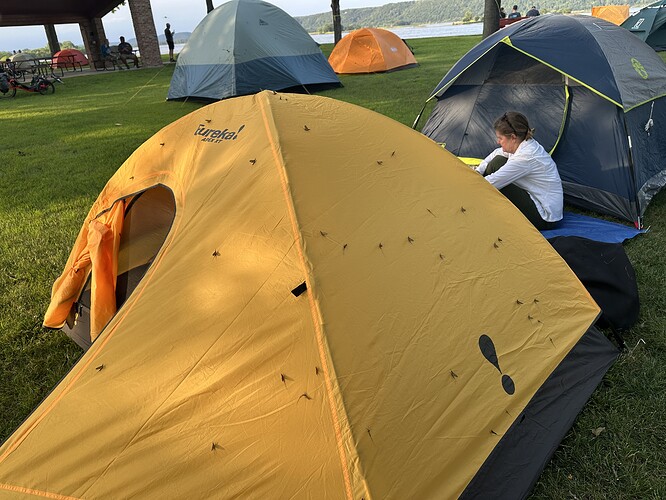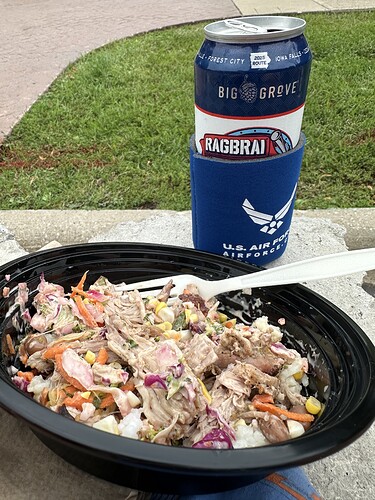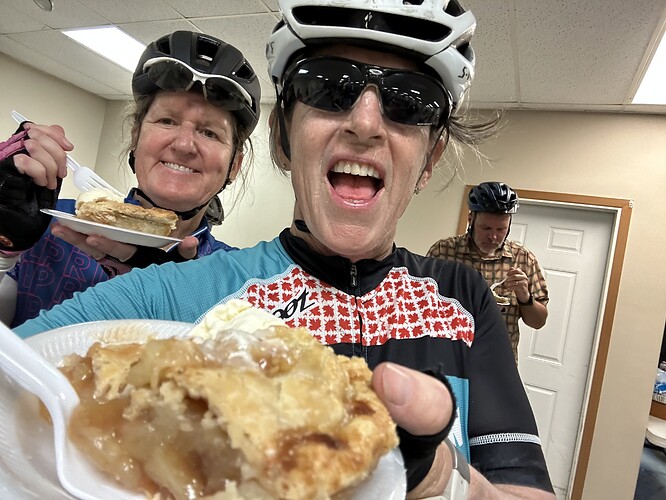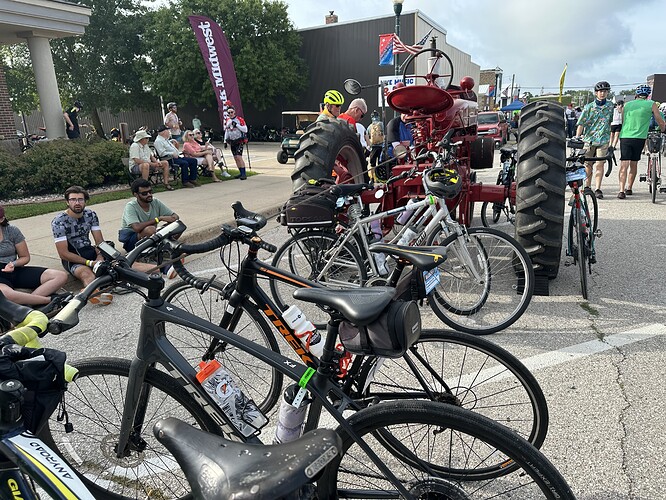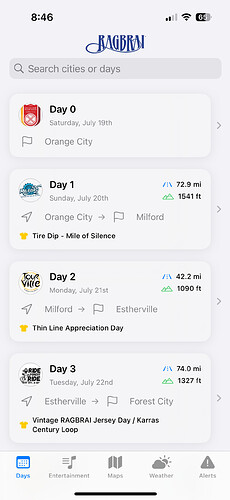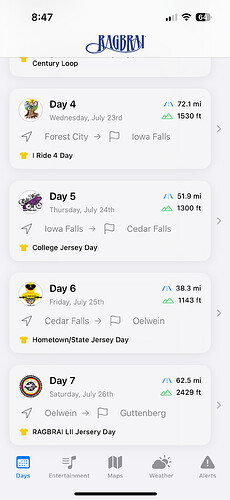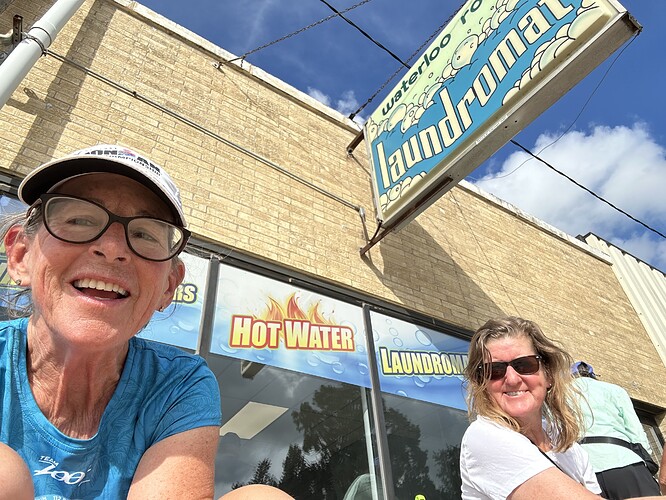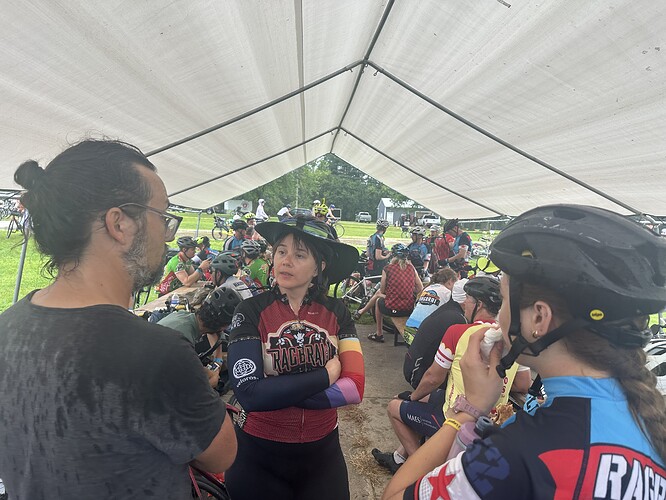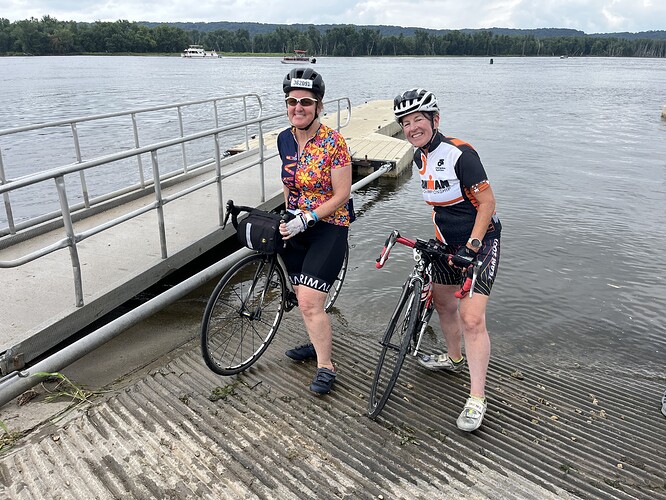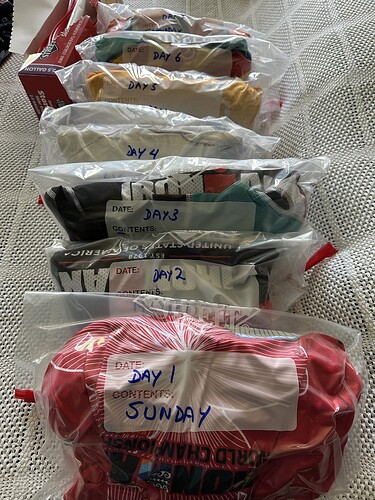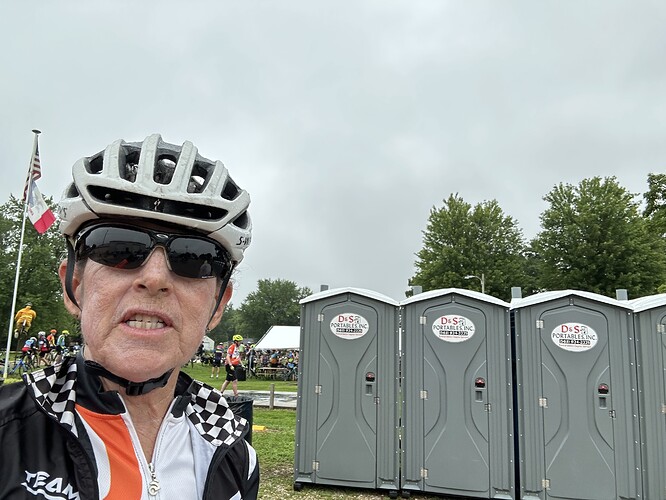Here is my ride report from RAGBRAI - The Des Moines “Register’s Annual Great Bike Ride Across Iowa,” submitted for those who might consider going next year.
Every January, a different west-to-east route spanning Iowa is announced for the following mid-to-late July. For about $250, registrants get RAGBRAI luggage hauling service (limit - one bag up to 50 pounds) and campsites for the seven days of riding and eight nights of camping. That’s the basic RAGBRAI. You pay for everything else, like meals, showers and beer.
For an additional fee, you can hire a charter service to carry your stuff from town to town, with amenities like a nice camping space, clean toilets/showers, pre-ride coffee and post-ride snacks and drinks, a big cooler for your personal beer supply, charging station for your devices, and a shaded hangout area with nice chairs. I used the excellent ARGO charter service for $640, which supplied all that. With ARGO, you finish your ride, find your bags in front of the cargo truck and you set up your own tent at their private campground. We camped on church lawns, high school ball fields, and other pleasant grassy areas.
You can spend more and get a charter that sets up your tent and puts your luggage in it, or charters that have sleeping cabins in trucks, and so on, but I was very happy with what ARGO offered.
A friend and I arrived in the end city, Guttenburg, on the east end of Iowa on Friday night. We camped in a public park on the shore of the Mississippi River, where a massive brood of Mayflies had just hatched. They live for a day and are attracted to bright colors, like my yellow tent rain fly. They don’t bite, but still, kinda gross.
It rained overnight, but luckily, it wasn’t raining Saturday morning while we packed up and took our stuff to the ARGO bus for the trip across Iowa to the starting point of Orange City, Iowa. A cargo truck took our bikes. About five hours later, we were there, where a giant expo was set up around the central park in Orange City. Very Dutch and tulip-themed, fun place to have dinner and a beer. RAGBRAI has its own beer.
We set up camp on a church lawn reserved by ARGO and it rained overnight. If you’re doing RAGBRAI, be sure your tent can withstand a good, heavy rainstorm because we had several this week.
On Day 1 of the ride, the route officially opens at 6a and stays protected and open until 9a, so I figured I was beating the crowd by waking up at 5:30a. I cannot stress how helpful it is to have earplugs and a sleeping mask to drown out road, camp and weather noise, however, it can cause a person to oversleep, which I realized when I came out of my tent and saw that one-third of my fellow ARGO campers had already left, and half of everybody else was already packing up.
It took us until about 7:15a to get everything packed and on the truck. (They want everything on the truck by 7:30a, so we were cutting it close. We were nearly the last riders to leave camp and join the ride. This is behavior we worked to change as the week went on.
That’s because the later you leave, the more crowded it is on the road, and slow going. There are some 20,000 riders on RAGBRAI, including people doing the full week, and lots joining the ride for just a couple of days. The roads are mostly closed to vehicles, but the later you leave, the more you are riding with people who are less skilled and more there for the celebratory crowd aspect — more like CicLAvia than Tour de Iowa.
Most of the people are on road bikes, some tri bikes, lots of gravel bikes (They have optional gravel sections!) and some people are proud to be “bagging it” by carrying all their luggage and camping gear with them. There are lots of tandems, including parents riding ahead of kids on tandem bike extensions or in trailers. There are also the attention suck riders, like the guy riding the route facing backwards, the guys riding unicycles, the fellow on a pennyfarthing, the guy running one leg of the route carrying an American Flag, and on and on.
If you like to ride with music, this is the place to bring your JBL bottle speaker, or even a big boombox on a rack. People like hearing your tunes.
On each day’s ride, there are pass-through towns where local groups sell fundraising foods like breakfast bowls, pies, fruit, coffee and so on. There’s a mid-ride meetup town where support vehicles and their drivers can connect with riders for lunch.
Best breakfast I had was pie and ice cream at a community center. That’s my friend Katie, who went along on this trip.
There are also attractions outside of the pass-through and meetup towns. Like Beekman’s home made ice cream, just $9 for a big cup of the best homestlye ice cream you ever had. And Mr. Pork Chop — where for $13, you get a really big butter-basted barbecued chop cooked over corn cobs.
There is also a lot of alcohol sold along the route. Apparently Iowa has a different take on drinking and riding than California. There were typically two beer gardens on farms serving Iowa craft beers. Mr. Pork Chop shares its farm sites with “Sassy Lemonade” spiked with Vodka. All the towns had beer, cocktails and Bloody Marys for sale. I don’t know how people can drink and ride, but at RAGBRAI it’s a thing.
And you’d never see this in Los Angeles, but on RAGBRAI, you park your bike anywhere and few people use locks. Lean it on a building, lean it on your buddy’s bike, lay it down on the grass (not me, not ever, who does that?), or you park it triathlon transition style on a cable suspended between two tractors. Hint: The closer you are to the tractor, the less likely your bike is to fall down because the cable is higher. Lower points on the cable in the middle are more risky. And very few people lock their bikes. I had a cable lock and used it about one-third of the time.
This was the shortest and flattest of the RAGBRAI routes, 406 miles over seven days and about 10,000 feet of climbing. Here, from the RAGBRAI app, are the mileage and elevation gain numbers.
On Day 3 there is an optional additional loop to take the 74 mile ride to a full Century. The weather early in the week was very hot — over 90 some days — with stifling humidity, and Day 4 was quite windy and exhausting. We were struggling to get our tents up after that ride. You want to put up your tent post-ride while you’re still sweaty because if you wait until after your shower, you just get sweaty again and have to wait in line again for a shower.
The weather was not cold except late at night, when it maybe got down to 50 degrees. Most nights, with the humidity and heat, I’d keep my rain fly open until around 10p and go to sleep in a sleeping bag liner because it was so warm. Then I’d close the rain fly as it cooled down and maybe get into the sleeping bag after midnight.
We had several nights of rain, even a violent lightning and thunder storm, so by morning our tent rain flys would be wet and we’d have to put it away in a plastic bag and then put it out to dry during the next afternoon. We were lucky that we never had to break camp in the rain, or that would have been miserable.
Mid-week, with our laundry piling up, we sought out a laundromat, and about a dozen other RAGBRAI riders had the same idea.
The last day of riding was through Amish communities, so we stopped to buy some nice baked goods and visit with people.
Our last day, we waited under a shelter for the first of the rain to let up, it did, we thought it was done, but no. We started riding again and got 2.5 hours of heavy rain. It wasn’t too cold, so it was tolerable.
The last day also had the most epic of the downhill stretches, with one last dramatic sweeping descent into the finishing town of Guttenburg. Thankfully, it was dry when I rode that.
A word on safety: There were two deaths on this year’s RAGBRAI, both probably health related, and there were a few crashes where, on the two-lane country roads, everybody dismounts and walks a few hundred yards to get past ambulance and SAG van. And a couple on a tandem crashed badly on that downhill sometime behind me on the final day, and word was they were in very bad condition. It’s still cycling, and you’re often passing or being passed by lots of other riders. Most everybody is trying to ride safely, but not all have the skills or habit to communicate what they’re doing and do it right. For example, you’ll have two people who are riding together, that’s fine, but they are taking up the entire right lane of a two lane road rather than holding to the right and taking up only half the lane, so everybody has to cross the yellow line to go around them.
The earlier you get going, the fewer sketchy riders you have to contend with, and that can be a safety factor when you’re speeding down a hill. There were also some big pacelines and pelotons that would zoom by on the left lane. Not dangerous, but they come up fast on the left.
Then we rode the last mile into town and stood in line to dip our tires in the Mississippi to ceremonially cap off the saga. Katie, left, me to the right.
Would I do it again? Not sure, but this ride did make me want to do more multi-day camping bike tours. At 406 miles and 10K of climbing, this was the shortest, flattest RAGBRAI in years. The day’s distances were between about 40 and 75 miles each day, so it is do-able for someone training for Ironman races or who does century rides. The distance and fatigue do mount up, because by Day 4 we were really tired, but then the shorter days after that were fine. They will announce the next year’s route in January.
If I did go, I would definitely use ARGO charter service again. It’s an Iowa family-run business that’s a moving company, but in July, they serve RAGBRAI riders. This year, they had 172 riders, and I generally didn’t have to wait more than a half-hour for a shower and the camp sites were first-class, with indoor shelters available in case of dangerous storms.
Finally some RAGBRAI tips:
The pace lines are tempting, but potentially dangerous because you don’t know the skill level of the riders in whatever train you’ve jumped on. That said, they are way faster than riding solo.
No matter how fast you ride, some dude on an e-bike playing loud music is going to pass you. You will zoom by the tandems on the flats and uphills and they will smoke you on the downhill.
The later you start your ride, the more crowded the road, the more chance you have of crashing. There were a couple of spots where cyclists crashed where the entire field of riders have to dismount and walk a few hundred yards to safely pass an ambulance. A couple people died on the route, but I don’t have details. There is some SAG service to help fix and haul you and your bike if you run into real trouble. There is also a fleet of Air Force Cycling Team folks to make it a point to stop and help any rider they see on the side of the road. And, of course, they published their stats, including thousands of what they called “positive interactions.” So no good deed goes uncounted.
Some people pack a ride kit for each day. That’s what I did. And wow, was I sorry that I chose to pack tri shorts for the longer days. I should have gone with bike shorts. Owie. Others will pack maybe three jerseys and shorts and wash them each day in hopes they will dry in time to use again. I saw lots of bike shorts turned inside out and pinned to tents to dry.
At every overnight town, RAGBRAI turns into a giant beer garden and there is a main stage that puts on a big show. I didn’t see any of the evening shows, preferring to hang out in our camp and go to bed around 8p. But there are shuttles that take people from the various charter campgrounds to the center of town for the festivities if that’s your thing.
There is a giant charter called Pork Belly Ventures that has various levels of service. They are so big that they put on their own entertainment, they have a la carte food trucks and shower trucks and so on. It’s a real crowd scene with long lines for things, so it’s something to keep in mind if you’re considering your charter options. People talk about having to wait long times to retrieve their bags from the luggage trucks at Pork Belly Ventures and the main RAGBRAI service. You might be saving money, but losing a lot of potential convenience.
The best and most economical food I had was the community fundraising dinners, typically $15 to $20 for a full dinner plus pie. Lots of pasta and noodle options. And often the pie was homemade. As the ride went on, we tried to seek out the local groups doing fundraising, versus the established vendors who would set up each day in the pass-through cities. But if you go, be sure to try the Beekman’s ice cream and Mr. Pork Chop at least once.
And a big surprise — the restrooms were surprisingly clean! Maybe because I got out on the route fairly early, but every single one was clean and usable!
